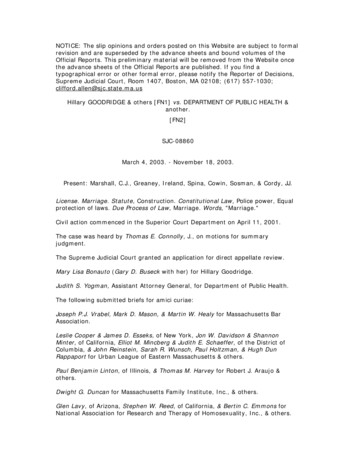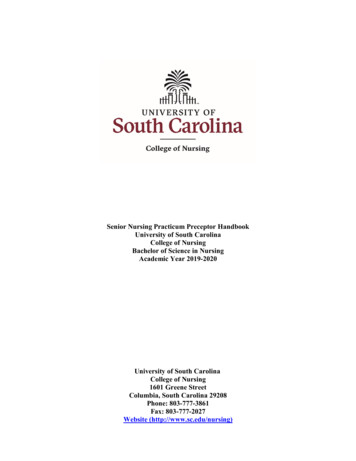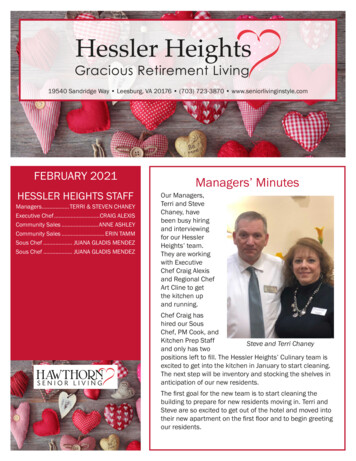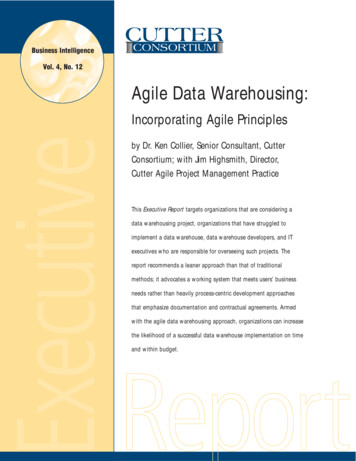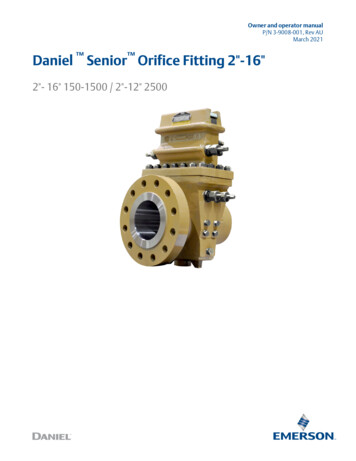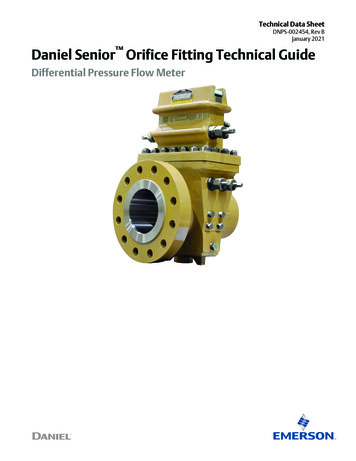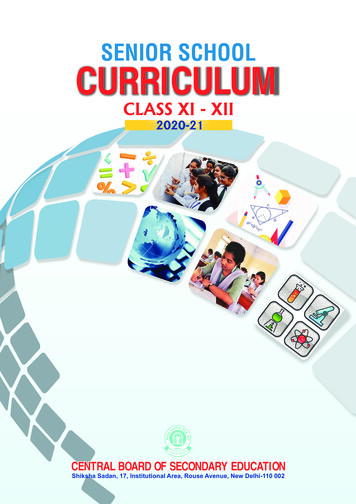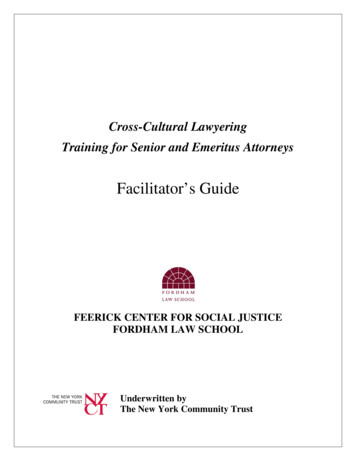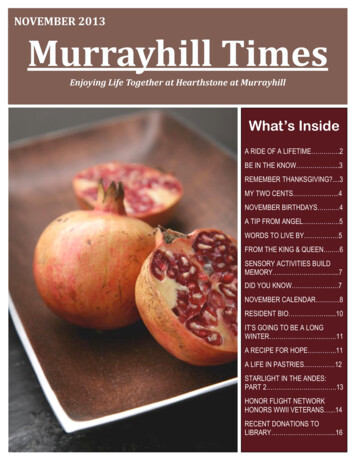
Transcription
Topçu and Kazan Egyptian Journal of Forensic Sciences (2018) 8:16DOI 10.1186/s41935-018-0045-yEgyptian Journal ofForensic SciencesORIGINAL ARTICLEOpen AccessThe opinions of senior nursing studentsabout forensic nursingEmine Tuğba Topçu*and Ebru Erek KazanAbstractBackground: Today, the increasing number of crime and violence cases is defined as a universal health problemand nurses are the first healthcare personnel to encounter victims and offenders in hospitals, emergency units,intensive care, and services, even at policlinics or on-scene; therefore, it is important that nurses receive educationin forensic nursing.Methods: This study was conducted as a descriptive study to determine the opinions of senior nursing studentsabout forensic nursing. This study was conducted with 95 students and its data were collected via a questionnairethat contains descriptive features and opinions about students’ forensic nursing education.Results: The results revealed that 94.7% of students believed that both forensic nursing should be an area ofspecialization and that nurses should receive forensic nursing education, 42.1% of them stated that this educationshould be given as an elective course in school, and 40% of the students stated that they wanted to become aforensic nurse when they graduated.Conclusions: The findings suggest that senior nursing students’ knowledge about forensic nursing was insufficientand that they were untrained in this area.Keywords: Critical care, Education nursing, Forensic medicine, Forensic nursing, Nursing studentPurposeThis study was conducted as a descriptive study todetermine the opinions of senior nursing students aboutforensic nursing.BackgroundThe modern world’s increasing number of crime andviolence cases is defined as a universal health problem, andnurses are the first healthcare personnel to encountervictims and offenders in hospitals, emergency units, intensive care, services, even at policlinics or on-scene (Sunmazet al. 2008; Sharma 2003). Nurses are generally the firsthealthcare personnel to observe patients, communicatewith patients’ family/relatives, examine patients andrequest patients’ laboratory samples (Lynch 2006; Stevens2004). However, evidence may be missed, lost, or destroyedduring treatment and care, especially if emergency servicesnurses are unaware of such evidence and do not know the* Correspondence: tgbtpc@hotmail.com; ettopcu@ybu.edu.trNursing Department, Yildirim Beyazit University Faculty of Health Sciences,Ankara, Turkeyprocedures and techniques for identifying, collecting, andkeeping it. This situation can make forensic review difficultand may lead to courts failing or making wrong decisions(Özden and Yildirim 2009). These difficulties in recognizing offender or victims and increasing the number ofvictims of crimes who are referred to hospitals, thenecessity of forensic nursing was revealed in the 1970s(Kent-Wilkinson 1999).In forensic nursing; nurses use the education they havetaken in forensics to examine the victims of violence,trauma, other criminal cases and death events. Inaddition they use this education make scientific investigations of this cases (Kent-Wilkinson 1999). In thisrespect, forensic nursing is one of the newest avenues offorensic science. Forensic nurses can work in emergencyservices, suicide prevention centers, rape crisis centers,crime scene investigations, death investigations, prisons,prosecutors’ offices, law offices, forensic pathologylaboratories, and at as expert witnesses in court (Lynch2011; Pinar and Bahar 2011). The Author(s). 2018 Open Access This article is distributed under the terms of the Creative Commons Attribution 4.0International License (http://creativecommons.org/licenses/by/4.0/), which permits unrestricted use, distribution, andreproduction in any medium, provided you give appropriate credit to the original author(s) and the source, provide a link tothe Creative Commons license, and indicate if changes were made.
Topçu and Kazan Egyptian Journal of Forensic Sciences (2018) 8:16Studies on forensic nursing in Turkey started in 1995.In recent years, forensic nursing is offered as an electivecourse at the undergraduate level in few universities.These universities are only about 10% of the totalnursing departments in Turkey. In Turkey, there are twouniversities have forensic nursing postgraduate programas well. Forensic nursing related sertificate courses areorganized by Association of Forensic Scientists andsome universities. Forensic nursing course; Definition offorensic medicine, history, definition of forensic nursing,duties and responsibilities, legal responsibilities ofnurses, forensic case types, case study, autopsy concept,changes after death. The fact that the forensic nursingcourse takes place at a very small number of universities,yet it is not clear that the awareness of forensic nursingin Turkey has not been developed yet, that adequatetraining is not given and that sufficient work has notbeen done in this area. Forensic nursing should be givenand spread throughout all nursing degree programs.Even though studies on forensic nursing have acceleratedin our country in recent years, unfortunately forensicnursing is not defined legally yet. However, despite thisfact, emergency nurses work as forensic nurses in forensiccases. Therefore, forensic cases are mostly assessed byemergency nurses who have not received special education(Yelken et al. 2004). Studies (Gökdoğan 2008; İlçe et al.2010; Topçu 2015) show that the vast majority of nursesencounter forensic cases, their knowledge and practice offorensic cases is inadequate and they have educationalneeds that are related to forensic nursing. It is very important to start this education at the undergraduate level.In the literature, there are few studies which examinedthe knowledge and opinions of nursing students aboutforensic nursing. In Turkey, only two studies (Şentürkand Büyükaslan 2013; Kalayci et al. 2014) have reportedthat students’ knowledge of forensic nursing isinadequate. In these studies conducted in the field offorensic nursing, the knowledge of students aboutforensic cases and forensic nursing was carried out indifferent cities with different questions and with fewersample groups. In a city with a high population, studentsare more likely to encounter forensic cases. During thetraining process, students are exposed to many forensicincidents by practicing in various hospitals. Therefore, itis thought that the study will be carried out in a citywith more population and population, which willcontribute to reveal the current situation. For thispurpose, our study was conducted with Ankara as thecapital of Turkey and with more sample groups.This study was conducted to determine the information needs and opinions of students related to forensicnursing, which is a new field of specialization in ourcountry, to determine the educational needs related tothe subject, and to draw attention to the topic.Page 2 of 7MethodsDesignThe research was carried out as a descriptive study.ParticipantsThe study sample was 104 students who were in thefinal year of the 2015–2016 academic year during thespring semester at the Department of Nursing, theFaculty of Health Sciences of a state university inAnkara, Turkey. In total, 95 students who were acceptedto participate in the survey were included.Data collectionData was collected via two questionnaire form that wasdeveloped by researchers parallel to the literature (Sunmazet al. 2008; Sharma 2003; Pinar and Bahar 2011; Yelkenet al. 2004). Totally it consisted of 21 questions. One ofthe data collection tools was a questionnaire (Form 1) (9questions) developed to determine the sociodemographiccharacteristics of the nursing senior students, and aquestionnaire (Form 2) (12 questions) to evaluate theopinions of the students about the forensic nursing. Form1 is included the six question that were related to age,gender, mothers’ and fathers’ education level, mothers’ andfathers’ job the students’ socio-demographic variablesconsisted of multiple-choice questions about students’sociodemographic characteristics, two questions were yes/no questions about the presence of someone interested inforensics in their family and sought to determine whetherthey followed forensic medicine cases in the media, theother one questions about publications you follow in themedia. Form 2 is included six questions were aimed at thetasks of forensic nurses, the fields in which they worked,forensic nursing subjects, examples of forensic cases andthe education of forensic nursing, which were designed sothat students could mark multiple choices. One openended question that was included was about the definitionof forensic nursing. The five questions regarding students’opinions about forensic nursing. One of them knowledgeof forensic nursing, one question want to be a forensicnursing, the other one forensic nursing should be proffesion, forensic nursing education is need and the last onethe cases in which they had encountered forensic caseswere designed as yes/no questions.ProceduresDuring the study’s implementation phase, informationwas first given to students about the research’s scope,and their written approvals were obtained. Then, a questionnaire was distributed to the students who had agreedto participate. After they completed the questionnaireform, these were collected by the researchers. Filling inthe form took approximately 20 min.
Topçu and Kazan Egyptian Journal of Forensic Sciences (2018) 8:16Ethical considerationsThe Research Ethics Committee’s approval was requiredfor the work to be done; this was taken from AnkaraYildirim Beyazit Ethics Committee of Social Sciencesand Humanities. Written permission was obtained fromthe institution at which the study was carried out.Students who agreed to participate in the study werenotified of the study and then their written approval wasobtained.Data analysesThe data were transferred to the computer program byresearchers using Statistical Package for the SocialSciences (SPSS) 16.0. Number percentages andchi-square tests were used to evaluate the data.ResultsIn the study, it was determined that the average age ofthe students was 22.2 0.79, 84.2% were female, 55.8%of their mothers had only graduated from primaryschool, 35.8% of their fathers had only graduated fromhigh school, 81.1% of their mothers were housewives,and 30.6% of their fathers were retired.It was determined that nearly all of the students (94.7%)had no family members interested in forensic medicine,27.4% followed forensic science, forensic nursing publications/programs in the media, and it was determined thatmost of them who did so used the Internet (80.8%) forthis. The majority of the students stated that they had noinformation about forensic nursing (77.9%) and almost allof them (98.9%) were untrained in forensic nursing.The students were asked about the definition of forensicnursing in the study; half of them (50.4%) stated that theydid not know what the forensic nursing was, while 17.9%defined forensic nursing as “nurses working and investigating in forensic cases” (Table 1). The students whoparticipated in the study were asked about the duties offorensic nurses; 42.1% stated that they did not know whatthe duties of the forensic nurses were and the othersstated “recording evidence” among the duties of forensicnurses (40.0%). Students selected “Forensic Science”(74.7%) among the subjects that the forensic nursesshould know, 82.1% stated that forensic nurses shouldwork in “forensic medicine institutions.” It wasdetermined that 93.7% of the students had not previouslyencountered forensic cases, and they mostly selected“sexual offenses” as forensic cases (81.1%) (Table 1).Of the students, 94.7% stated that both forensicnursing should be an area of specialization and thatnurses should receive forensic nursing education, 42.1%stated that this education should be given as electivecourse at school, and 40% stated that they wanted to beforensic nurses when they graduated (Table 2).Page 3 of 7It was determined that the differences between thegroups was not significant when the socio-demographiccharacteristics of the students were age, gender, parents’educational level, parents’ jobs, presence of a person interested in forensic medicine in the family, independentfollow-up on forensics in the media, and knowledge andviews on forensic nursing (p 0.05).DiscussionUpon examining the educational status and jobs of thestudents’ parents, they were moderate in terms of thesociocultural level. In our study, very few students statedthat they had someone interested in forensic medicineamong their family. However, it was determined that thisdid not affect students’ knowledge level with regard toforensic nursing (p 0.05). Similar to our study, in thestudy by Şentürk and Büyükaslan (2013) that sought todetermine the knowledge and opinions of senior nursingstudents about forensic nursing, only 12% of them had afamily member who was interested in forensic medicine.Most of the students had no one who was interested inforensics in their family, and it was thought that thissituation might affect the level of knowledge and awareness about forensic cases.Nurses are responsible for evaluating patients in acomprehensive manner, identifying problems intervention to solve problems and recording when the patientscome to the emergency services due to health problems.These duties of nurses are also applicable in forensicscases. In addition, it is expected in forensic cases thatnurses will collect forensic evidence and keep and givethem to competent authorities (Green 1993). In ourstudy, nearly half of the students stated that they did notknow what forensic nurses’ duties would be, and theychose the furthest “recording of evidences” among theduties of forensic nurses (Table 1). This finding suggeststhat the most important thing that students perceive asthe duties of forensic nurses is limited to the
information about forensic nursing (77.9%) and almost all of them (98.9%) were untrained in forensic nursing. The students were asked about the definition of forensic nursing in the study; half of them (50.4%) stated that they did not know what the forensic nursing was, while 17.9% defined forensic nursing as “nurses working and investi-
